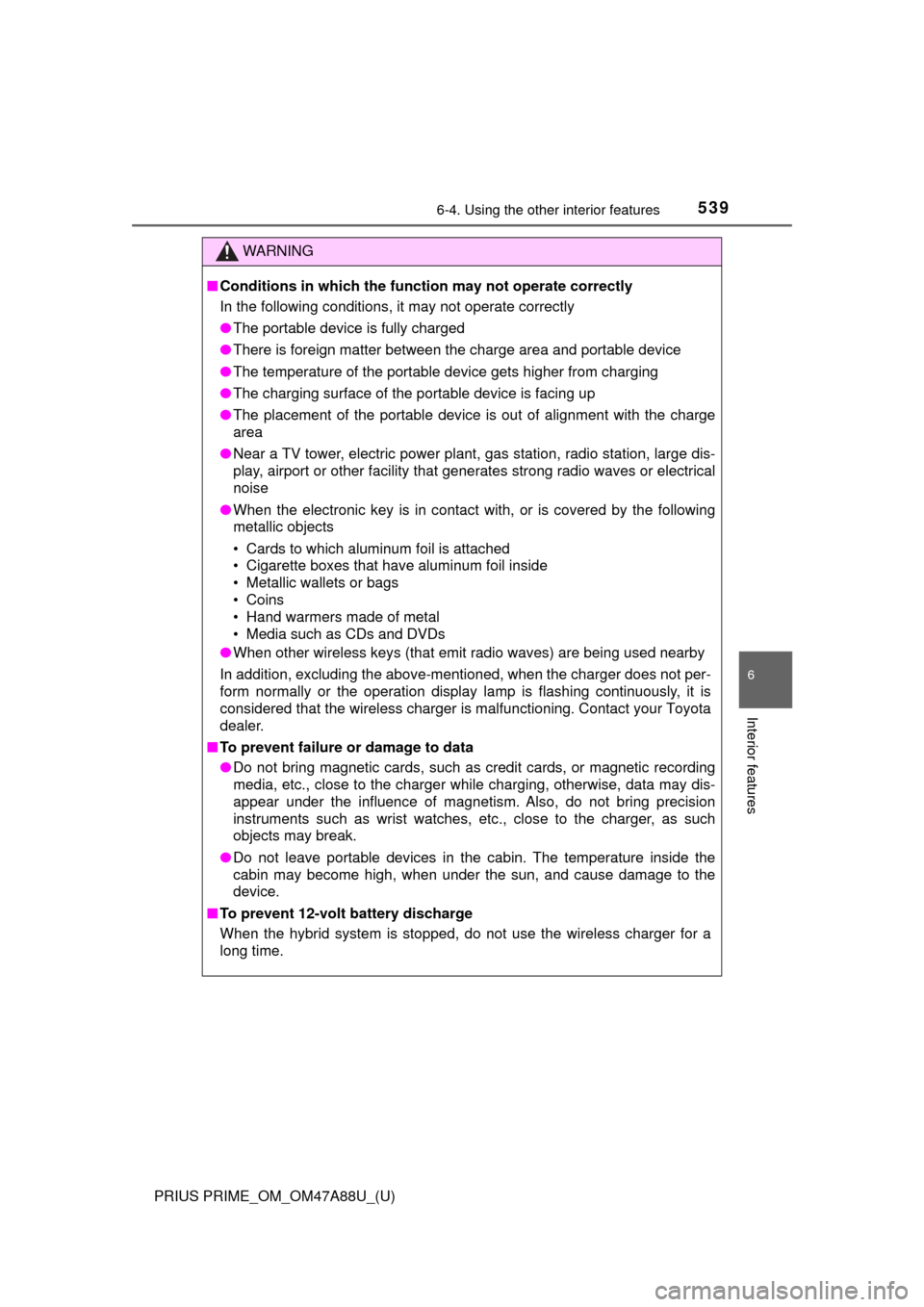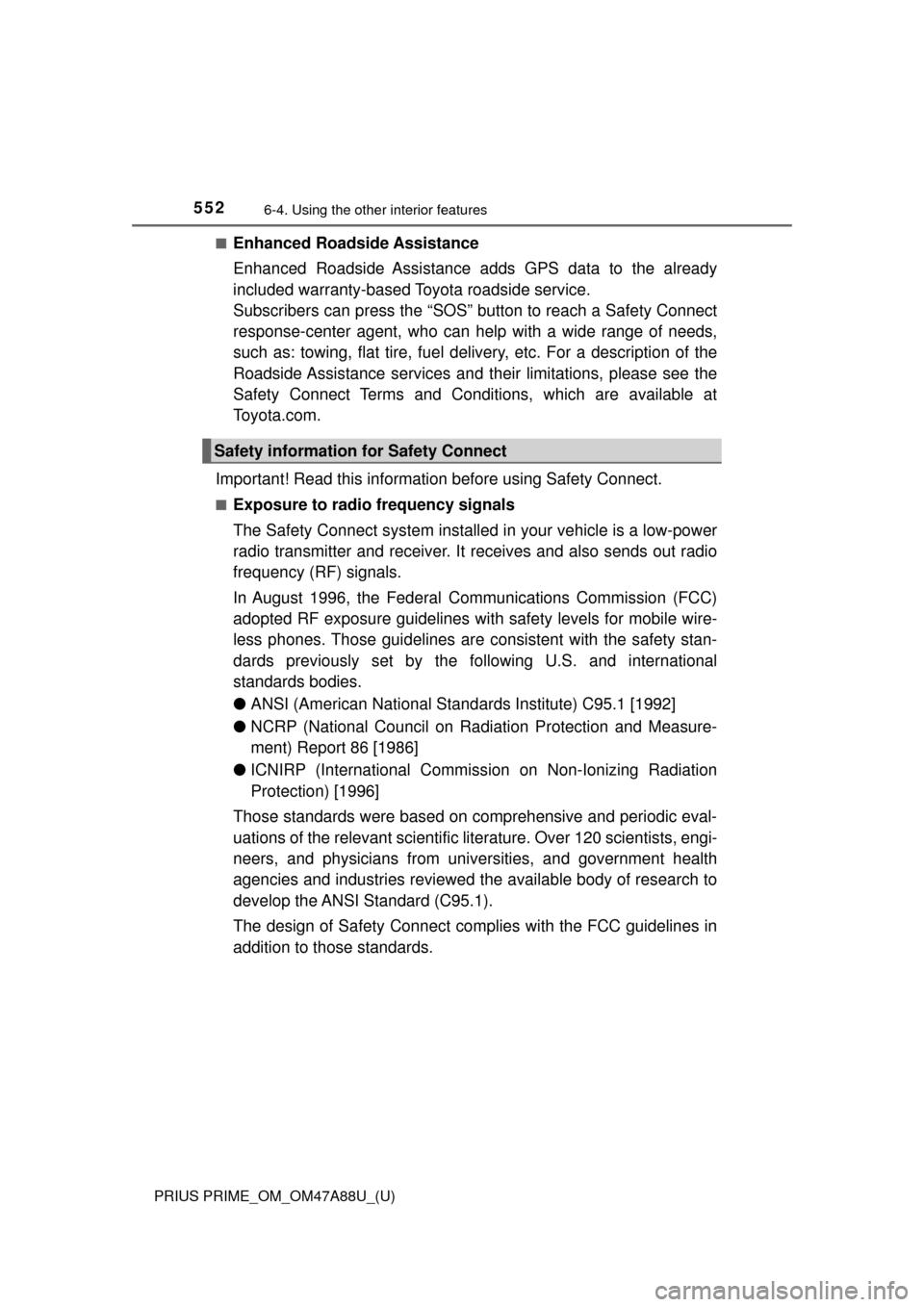Page 521 of 784
PRIUS PRIME_OM_OM47A88U_(U)
5216-3. Using the storage features
6
Interior features
●When storing a bottle, close the cap.
● The bottle may not be stored depending on its size or shape.
Bottle holders/door pockets
Front doorsRear doors
NOTICE
Put the cap on before stowing a bottle. Do not place open bottles or glass
and paper cups containing liquid in the bottle holders.
The contents may spill and glasses may break.
IO63PH022
Page 523 of 784
523
PRIUS PRIME_OM_OM47A88U_(U)
6-3. Using the storage features
6
Interior features
Luggage compartment features
■When installing the deck board
Auxiliary boxes
CenterRight side
Pull the strap upwards to lift up
the deck board.
The luggage cover, charging cable,
tool bag, etc. can be stowed.
Pull the strap upwards to lift up
the deck board.
Insert the claw in to the hole, and return
the deck board.
WARNING
If the deck board is removed, return it to its original positions before driving.
In the event of sudden braking, an accident may occur due to an occupant
being struck by the deck board or the items stored in the auxiliary box.
Page 524 of 784
524
PRIUS PRIME_OM_OM47A88U_(U)
6-3. Using the storage features
When using the hooks, press the
bottom side to lift it up.
There also is a hook on the other
side.
The warning reflector can be
stowed.
(The warning reflector itself is not
included as an original equipment)
Depending on the size and shape of the warning reflector case, etc., you may
not be able to store it.
NOTICE
To prevent damage to the deck board, do not apply too much load on the
deck board.
Grocery bag hooks
NOTICE
In order to prevent damage to the grocery bag hooks, do not place large
objects or objects that weight more than 8.8 lb. (4 kg) onto the hooks.
Warning reflector storage space
WARNING
When storing the warning reflector, etc., make sure that it is properly stored.
If the warning reflector is not properly stored, it may fly out during emer-
gency braking and lead to an accident.
Page 525 of 784
PRIUS PRIME_OM_OM47A88U_(U)
5256-3. Using the storage features
6
Interior features
Ty p e A
■Installing the luggage coverRemove the luggage cover from the bag.
Slowly unfold the luggage cover.
■Stowing the luggage cover
Hold the luggage cover with
both hands. Point your
thumbs in opposite direc-
tions.
Luggage cover
1
2
Attach the hook to the hook
brackets.3
Black cap
Gray cap
1
Page 526 of 784
526
PRIUS PRIME_OM_OM47A88U_(U)
6-3. Using the storage features
Bend one side of the cover
towards you.
Twist the other side in the
opposite direction, as shown
in the illustration.
Make a small circle, then fold
it inward.
Make sure the three circles
are side by side.2
3
4
5
Page 528 of 784
528
PRIUS PRIME_OM_OM47A88U_(U)
6-3. Using the storage features
■Removing the luggage cover
Push one end of the luggage
cover inward and remove it
from the holder.
■Stowing the luggage cover
Remove the deck boards.
Store cover in the center aux-
iliary box.
Return the deck boards to its original position and close it.
1
2
3
Page 539 of 784

PRIUS PRIME_OM_OM47A88U_(U)
5396-4. Using the other interior features
6
Interior features
WARNING
■Conditions in which the function may not operate correctly
In the following conditions, it may not operate correctly
● The portable device is fully charged
● There is foreign matter between the charge area and portable device
● The temperature of the portable device gets higher from charging
● The charging surface of the portable device is facing up
● The placement of the portable device is out of alignment with the charge
area
● Near a TV tower, electric power plant, gas station, radio station, large dis-
play, airport or other facility that generates strong radio waves or electri\
cal
noise
● When the electronic key is in contact with, or is covered by the following
metallic objects
• Cards to which aluminum foil is attached
• Cigarette boxes that have aluminum foil inside
• Metallic wallets or bags
• Coins
• Hand warmers made of metal
• Media such as CDs and DVDs
● When other wireless keys (that emit radio waves) are being used nearby
In addition, excluding the above-mentioned, when the charger does not per-
form normally or the operation display lamp is flashing continuously, it is
considered that the wireless charger is malfunctioning. Contact your Toyota
dealer.
■ To prevent failure or damage to data
● Do not bring magnetic cards, such as credit cards, or magnetic recording
media, etc., close to the charger while charging, otherwise, data may dis-
appear under the influence of magnetism. Also, do not bring precision
instruments such as wrist watches, etc., close to the charger, as such
objects may break.
● Do not leave portable devices in the cabin. The temperature inside the
cabin may become high, when under the sun, and cause damage to the
device.
■ To prevent 12-volt battery discharge
When the hybrid system is stopped, do not use the wireless charger for a
long time.
Page 552 of 784

552
PRIUS PRIME_OM_OM47A88U_(U)
6-4. Using the other interior features
■Enhanced Roadside Assistance
Enhanced Roadside Assi stance adds GPS data to the already
included warranty-based Toyota roadside service.
Subscribers can press the “SOS” bu tton to reach a Safety Connect
response-center agent, who can help with a wide range of needs,
such as: towing, flat tire, fuel deli very, etc. For a description of the
Roadside Assistance se rvices and their limitations, please see the
Safety Connect Terms and Conditions, which are available at
Toyota.com.
Important! Read this informatio n before using Safety Connect.
■Exposure to radio frequency signals
The Safety Connect system install ed in your vehicle is a low-power
radio transmitter and receiver. It receives and also sends out radio
frequency (RF) signals.
In August 1996, the Federal Communications Commission (FCC)
adopted RF exposure gui delines with safety levels for mobile wire-
less phones. Those guidelines are c onsistent with the safety stan-
dards previously set by the fo llowing U.S. and international
standards bodies.
● ANSI (American National Stand ards Institute) C95.1 [1992]
● NCRP (National Council on Radi ation Protection and Measure-
ment) Report 86 [1986]
● ICNIRP (International Commiss ion on Non-Ionizing Radiation
Protection) [1996]
Those standards were based on comprehensive and periodic eval-
uations of the relevant scientific literature. Over 120 scientists, engi-
neers, and physicians from uni versities, and government health
agencies and industries reviewed t he available body of research to
develop the ANSI Standard (C95.1).
The design of Safety Connect complies with the FCC guidelines in
addition to those standards.
Safety information for Safety Connect